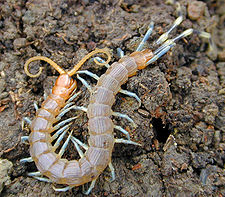Ecdysozoa: Difference between revisions
m Removed taxobox colour. See User:Eubot/Removing colours from taxoboxen. |
m Removed Panarthropoda from taxobox as this seems to be a rare classification. |
||
| Line 18: | Line 18: | ||
* [[Nematomorpha]] |
* [[Nematomorpha]] |
||
* [[Lobopodia]] [[extinction|†]] |
* [[Lobopodia]] [[extinction|†]] |
||
* [[Onychophora]] |
|||
* '''''[[Panarthropoda]] (unranked)''''' |
|||
* [[Tardigrada]] |
|||
* [[Arthropoda]] |
|||
** [[Arthropoda]] |
|||
}} |
}} |
||
Revision as of 15:50, 10 March 2008
| Ecdysozoa Temporal range: Early Cambrian - Recent
| |
|---|---|

| |
| Centipede | |
| Scientific classification | |
| Kingdom: | |
| Subkingdom: | |
| Superphylum: | Ecdysozoa Aguinaldo et al., 1997
|
| (unranked): | |
| Phyla | |
The Ecdysozoa are a group of protostome animals, including the Arthropoda (insects, arachnids, crustaceans, et cetera), Nematoda, and several smaller phyla. They were first defined by Aguinaldo et al. in 1997, based mainly on trees constructed using 18S ribosomal RNA genes.[1] The group is also supported by morphological characters, and can be considered as including all animals that shed their exoskeleton (see ecdysis). Groups corresponding roughly to the Ecdysozoa had been proposed previously by Perrier in 1897 and Seurat in 1920 based on morphology alone.
Group characters
The most notable characteristic shared by ecdysozoans is a three-layered cuticle composed of organic material, which is periodically molted as the animal grows. This process is called ecdysis and gives the group its name. The Ecdysozoans lack locomotory cilia, produce mostly amoeboid sperm, and their embryos do not undergo spiral cleavage as in most other protostomes. Various other features are found in the group — for instance, both tardigrades, pycnogonids and roundworms have a triradiate pharynx.
The Ecdysozoa include the following phyla: Arthropoda, Onychophora, Tardigrada, Kinorhyncha, Priapulida, Loricifera, Nematoda and Nematomorpha. A few other groups, such as the gastrotrichs, have been considered possible members but lack the main characters of the group, and are now placed elsewhere. The Arthropoda, Onychophora and Tardigrada have been grouped together as the Panarthropoda because they are distinguished by segmented body plans.[2]
The non-panarthropod members of Ecdysozoa have been grouped as Cycloneuralia but they are more usually considered paraphyletic.
The grouping proposed by Aguinaldo et al. is not universally accepted. Some zoologists still hold to the view that Panarthropoda should be classified with Annelida and that Ecdysozoa are polyphyletic. Especially the highly derived roundworms, with their many parasitic taxa and a considerable number of autapomorphies continue to pose problems.
- Cuticular epithelia are widely spread over diverse phyla of invertebrates (including some groups outside Ecdysozoa) and show a considerable degree of variation. They are believed to have evolved independently, at least in some groups. In Nematoda and Panarthropoda, the cuticle is different in both chemical composition and ultrastructure, which means that it may have evolved independently.
- Molecular evidence for the monophyly of Ecdysozoa is also ambiguous.[3]
One of the proposed solutions is to regard Ecdysozoa as a sister-group of Annelida,[4] however the controversy is still far from closure.[5]
A partial phylogenetic tree of the Ecdysozoa hypothesis is as follows.[6]
References
- ^ Aguinaldo, A. M. A., J. M. Turbeville, L. S. Linford, M. C. Rivera, J. R. Garey, R. A. Raff, & J. A. Lake, 1997. Evidence for a clade of nematodes, arthropods and other moulting animals. Nature 387: 489-493.
- ^ Paleos Invertebrates: Panarthropoda - URL retrieved February 17, 2007
- ^ Blair, J. E. , Kazuho Ikeo, Takashi Gojobori and S. Blair Hedges The evolutionary position of nematodes BMC Evolutionary Biology 2002, 2:7 doi:10.1186/1471-2148-2-7 and a discussion in: Wägele, J. W., T. Erikson, P. Lockhart, & B. Misof (1999) The Ecdysozoa: Artifact or monophylum? Journal of Zoological Systematics and Evolutionary Research 37: 211-223; Wägele, J. W. & B. Misof. (2001) On quality of evidence in phylogeny reconstruction: a reply to Zrzavý's defence of the 'Ecdysozoa' hypothesis. J. Zool. Syst. Evol. Research 39:3, 165-176 (criticising Ecdysozoa) and Zrzavy, (2001) Ecdysozoa versus Articulata: clades, artifacts, prejudices J. Zool. Syst. Evol. Research 39:3, 159-163. (supporting Ecdysozoa)
- ^ Nielsen, C. (2003) Proposing a solution to the Articulata–Ecdysozoa controversy. Zoologica Scripta 32:5, 475-482
- ^ Jenner, Ronald A. Unleashing the force of cladistics? Metazoan phylogenetics and hypothesis testing. Integrative and Comparative Biology, Feb 2003
- ^ Tree of Life web project - Bilateria - accessed January 8 2007
